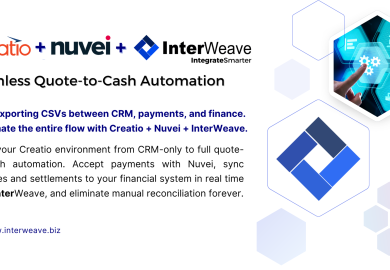- SOLUTIONS
- Industries
- Resource Center
- Support
- Company

A Guide to Open Architecture, API Flexibility, and Future-Proofing Your Tech Stack
Vendor lock-in happens when businesses become overly dependent on one provider’s ecosystem—making it hard (and expensive) to switch tools or scale. But with the right integration strategy, you can build a flexible, modular tech stack that evolves as your business grows. Here’s how smart integration platforms like InterWeave SmartSolutions help you break free.
What Is Vendor Lock-In?
Vendor lock-in occurs when:
- Your systems only work with a single vendor’s tools
- You face high switching costs, loss of data, or major rework when migrating
- You can’t easily integrate with new software or cloud services
The result? Limited flexibility, slower innovation, and rising costs over time.
How Smart Integration Platforms Prevent Lock-In
1. Open Architecture
- InterWeave is platform-agnostic, meaning it connects any combination of CRM, accounting, ERP, or payment systems.
- No dependency on a single software ecosystem (e.g., Salesforce-only or Microsoft-only environments).
Example: Use Salesforce today, switch to Creatio tomorrow—your workflows stay intact.
2. API-Driven Flexibility
- Connects to any application that supports REST, SOAP, OData, or Web Services.
- Offers robust field mapping, data transformation, and event-based triggers—all configured through the UI.
APIs make it possible to plug and unplug tools without rebuilding your core.
3. No-Code Configuration
- Avoid hardcoded logic that’s tied to one vendor’s system.
- InterWeave uses profiles—modular, reusable configurations that can be cloned or adapted across apps.
This modularity ensures you can swap systems without losing automation logic.
4. Data Portability & Real-Time Sync
- Data doesn’t live in silos—it’s synced between systems in real-time.
- You can extract or migrate data easily because InterWeave doesn’t trap it inside proprietary formats.
Full access, full control.
5. Scalable & Future-Proof
- Start small with CRM-to-Accounting, then add payments, inventory, support tools, or BI platforms over time.
- New systems can be connected with minimal business disruption.
Integration grows with your business—not against it.
InterWeave in Action: A Lock-In-Free Workflow
You integrate Salesforce + QuickBooks + Authorize.net via InterWeave.
Later, you migrate from QuickBooks to Sage Intacct.
✅ No need to rebuild everything—just update the profile to map new fields and endpoints.
✅ Workflows stay the same.
✅ Users never feel the switch.
How to Stay Agile and Avoid Vendor Lock-In
| Strategy | Why It Matters |
| Use open APIs | Ensures broad compatibility across vendors |
| Choose platform-agnostic tools | Avoids ecosystem restrictions |
| Go no-code where possible | Reduces rework and technical debt |
| Prioritize data portability | Keeps you in control of your own information |
| Pick scalable integration layers | Lets you switch or scale tools freely |
Final Thought:
The best integration platform doesn’t lock you in—it unlocks your options.
With InterWeave, you build a connected business that can evolve, adapt, and grow—without being tied to any single vendor.
Recent Posts
Recent Posts
- How Creatio + Nuvei + InterWeave Deliver a 360° Quote-to-Cash and Payment Reconciliation Experience
- How to ensure data integrity across all connected systems?
- Case Study: How a nonprofit automated its donation processing via InterWeave
- How can businesses avoid vendor lock-in with smart integration platforms?
- Top 5 financial reports your integrated system should provide automatically?





